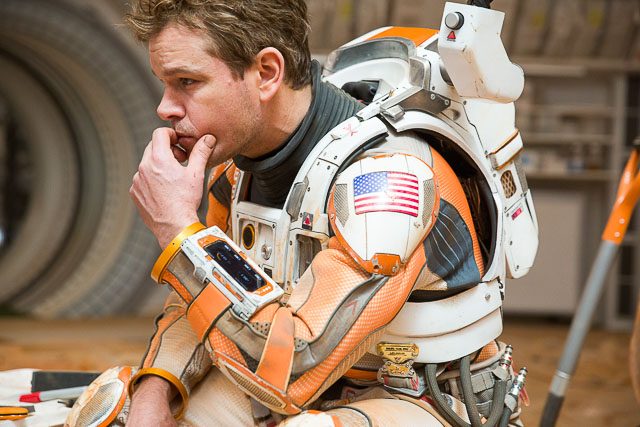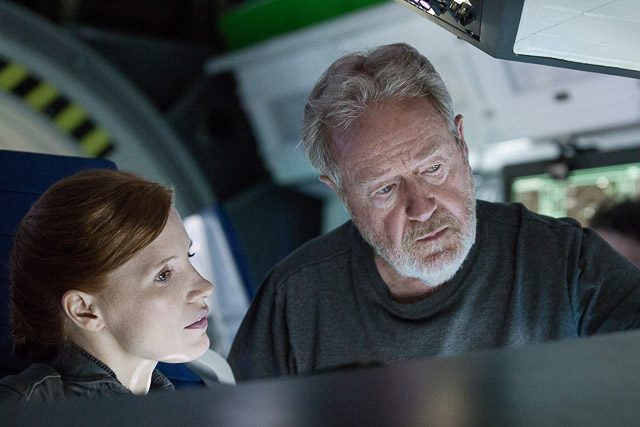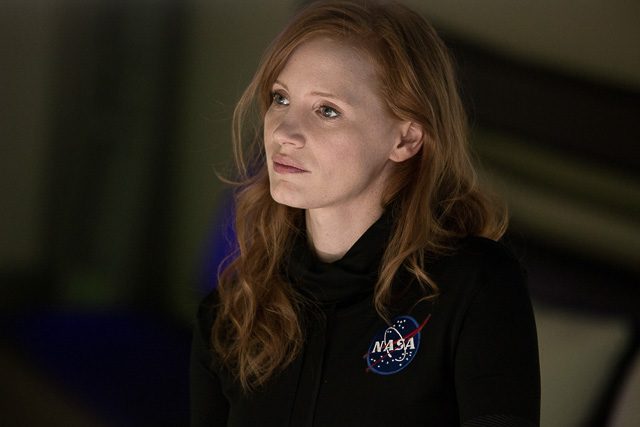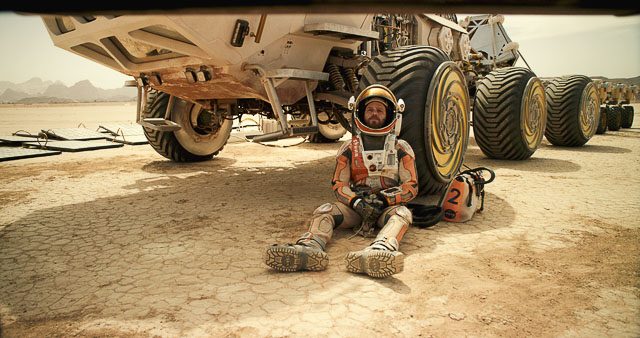SUMMARY
This is AI generated summarization, which may have errors. For context, always refer to the full article.

MANILA, Philippines – With seminal sci-fi classics like Blade Runner and Alien under his belt, Ridley Scott is just the right man to helm the film adaptation of The Martian.
Adapted by screenwriter Drew Goddard (The Cabin in the Woods, Buffy the Vampire Slayer) from the eponymous best-selling web fiction series-turned-novel by Andy Weir, The Martian takes place in a not-so-distant future where manned missions to Mars have become a routine reality.
Ares 3, the latest, takes astronaut and botanist Mark Watney (Matt Damon, the Bourneseries, Interstellar) on a sojourn to the Red Planet.
However, the mission goes awry when a dust storm wreaks havoc on their base camp in Acidalia Planitia. Commander Melissa Lewis (Jessica Chastain, Zero Dark Thirty, Interstellar) is forced to call the entire thing off and evacuate her crew.
In the scramble, the freak winds send an antenna hurtling towards Watney, effectively conking out all communications – except for one clear message that the Ares 3 astronauts deduce: he is dead.
…or so they thought.
Incredible odds seem to have favored Watney, who finds himself marooned on the red badlands with no ready means to send a distress signal. Even if he manages to send SOS and gets it to mission control in Houston, the supplies are scarce and he would starve before any rescue mission. This, plus Murphy’s Law – anything that can go wrong will go wrong – in effect in an already hostile environment.
But Watney refuses to go down without a proper fight, and calculates his next moves with nuts-and-bolts precision. Thankfully, too, he has his sardonic wit to keep him sane and to empower him to surmount all the odds. He’s a tad gung-ho about the entire situation, too, saying, “I’m gonna have to science the sh*t out of this.”
In The Martian, Ridley Scott eschews the grim dystopia of Blade Runner and the menacing Xenomorphs of Alien, tapping instead into his comedic arsenal (i.e. Thelma and Louise and Matchstick Men) to capture this distinct gallows humor.

In the film, there are hardly hints of metaphysical paeans to human indomitability. Instead, there are f-bombs galore and a running gag about disco music. It salutes human ingenuity, with Watney formally colonizing Mars with poo and potatoes.
Following the box office and critical successes of epic space exploration flicks like Alfonso Cuarón’s Gravity and Christopher Nolan’s Interstellar, the British filmmaker’s take on The Martian can’t sidestep the comparisons. Like the two aforementioned films, it places a premium on scientific rigor.
It also certainly makes NASA look good. The space agency was hands-on for some aspects of the film, even though its top scientists were depicted a bit like the bumbling folks in The Office or Veep. The Martian even serendipitously rides the hype following the “discovery” of water trickling down the Red Planet’s valleys and craters, but this might have changed key scenes. (READ: Evidence of brine ‘flows’ on Mars –water study)
In the midst of all the perils, there are also guffaws to be drawn from the oft-campy humor in the vein of Marvel’s Guardians of the Galaxy – delivered on point by lead actor Matt Damon.
The Martian lines up an all-star cast in supporting roles: Jessica Chastain, Jeff Daniels (The Newsroom), Sean Bean (Game of Thrones, The Lord of the Rings trilogy), Kristen Wiig (Saturday Night Live), Chiwetel Ejiofor (12 Years a Slave), Sebastian Stan (Captain America: The Winter Soldier), Michael Peña (Ant-Man), Kate Mara (House of Cards), and Donald Glover (a.k.a. Childish Gambino, Community) – among others.

When Earth finds out that Watney has actually survived, they work together to “all save one dorky botanist,” as the novel puts it.
Ridley Scott uses his world-building skills as a former production designer to let the Wadi Rum valley in Jordan and a soundstage in Budapest, Hungary stand in for Mars and spacecraft Hermes, respectively.
In this interview provided to Rappler by 20th Century Fox, he talks about what made him sign on for the project and about working closely with NASA’s astronomers and engineers to help make The Martian the entertaining ride that it is.
You’re always very busy, so what was it that hooked you into this story?
I think the book was amazingly practical and entertaining and challenging in every shape and form – it wasn’t just another space movie. It was ‘you can survive.’ If you read this book carefully, it will help you survive.
And I think it’s really amusing as well. So a good lesson for us all – if you apply this to life you’ll come out in one piece.
Andy Weir, the author of the book, obviously went to great lengths to make the science accurate. Was that important for your film too?
I was never very good at mathematics so I had to get my head round ASCII [American Standard Code for Information Exchange].
And eventually I actually worked it out with the help of the art department who explained it to me so many times, as if they were explaining two and two makes four. But ASCII is quite complex and in its simplest form it’s about letters in relations to numbers and the penny eventually dropped.
But I like to do things visually so I would have [Matt as Mark Watney] do things like walk in a circle with a string to his nose and you think ‘what the hell is doing?’ Because I like the idea of combining state of the art technology – things like the Habitat, and his space suit, which are keeping him alive – and yet he is also using a bit of string and some gaffer tape to save his life.
You mentioned his humor and a different movie about a man stranded on Mars would have had him wallowing in loneliness. And yet Watney has this determination to survive and the humour to keep himself buoyant.
He’s funny and Matt and I talked at length about this because he said ‘there’s a lot of voice over…’ And I said yes, but the voice over is divided into three categories.
And we are going to give you a ‘buddy’ – what we call a GoPro [high definition camera] – in almost every space. It will be in the Hab [Habitat] and in the Rover [surface vehicle]. There will be maybe 50 in the Habitat, in the laboratories and even in the shower room because if anything goes wrong, the GoPro is like a Black Box on an aircraft, it will be capturing information and NASA will want to see what happened.
So suddenly Watney is being recorded every inch of the way and that becomes a companion for him, because he can talk into the camera. He frequently changes tone and talks to the camera as if it’s a friend because, in effect, that is his buddy. So that takes care of 40 per cent of it because it’s almost like he has a friend with him and the rest is straightforward voice over, rumination, him working things out.

What was the central theme for you? The desire not to leave somebody behind no matter what?
Absolutely, and that is NASA and JPL [Jet Propulsion Laboratory] and who they are. JPL is a community of scientists in California where they create instruments and robots and put them in space to do things.
NASA is about vehicles that are man driven and they have their different dress codes [laughs]. In NASA they are in the suits and ties and at JPL they are like a relaxed bunch of hippies [laughs].
But they work together and they never leave anyone behind. And that’s what happens in our story – they will do anything to bring Watney home. And that’s a very powerful narrative – will Watney be able to survive long enough to be rescued?
I like the way Teddy [Sanders] played by Jeff Daniels at first seems like a pretty tough head of NASA. But what else are you going to do? You have to be tough to be kind.
You must have been very excited about creating the Mars landscapes. How did you approach that?
Well, I’d been to Wadi Rum [in southern Jordan] where I shot part of the Hittite battle for Exodus: Gods and Kings but the rest of the landscapes for that were in Fuerteventura [in the Canary Islands] so I had never really put a big unit on the ground in Jordan and I felt this was the moment to do it.
And before we set foot in the studio in Budapest we had to choose the nestling rocks [in Wadi Rum] that the Habitat would be sheltered by and cover it, 360 degrees, with digital cameras, and then when I got back to the studio in Budapest – which is a huge studio, bigger than the Bond stage in Pinewood – I could dovetail them together. And you can’t spot what is effect and what isn’t; you can’t tell what is studio and what was Wadi Rum.
You said recently that you adore the science fiction genre. What is it that you love about creating these other worlds?
Well, it’s a challenge and I can’t shake the designer out of me. I’ve always loved that side of making films. I love to create other worlds. I don’t care whether it’s period, like Kingdom of Heaven, with the crusades or it’s futuristic, the challenge is the same.
In a funny kind of way, futuristic is more difficult than period because period you have lots of references to go to and with futuristic you try not to repeat yourself so you are constantly having to re-think [space] suits, re-think ships, re-think technology and what it’s going to look like and that in itself is fascinating.

And I understand that you had a lot of cooperation from NASA in that regard for The Martian. How important was that?
Well, first of all it’s great to get their support and enthusiasm. And they have seen the film – 14 representatives of NASA saw the film a couple of weeks ago and that went very well, they went nuts over it. They went, ‘Jesus Christ, this will help us get funding!’ [laughs]. So that was nice.
So NASA showed us what they were thinking about for the future in terms of suits and vehicles, things like that, and we look at it and it was quite amusing because I said, ‘hmm, don’t like the suits, dude…’ [laughs]. And they said ‘no, nor to we! What are you going to do?’ And I said, ‘I’ll show you…’ So we did the suits and then they looked at them and said ‘oh, that’s cool…’
With NASA, if you go way back to Stanley Kubrick, he used a guy called Robert McCall [conceptual designer on 2001: A Space Odyssey and an artist commissioned by NASA] and one of McCall’s beautiful murals is on the wall at the entrance to [the Lyndon B. Johnson Space Center] in Houston, I believe, and it’s very beautifully done. And on it is the white doughboy suits from 2001 and a montage of other space objects painted in the luminous light.
He was a genius and he helped Stanley design a lot of the interiors on 2001. I think Stanley was paranoid that NASA was going to beat him to it and he wanted to be ahead of them. So all of that stuff is brilliantly designed and the threshold of all space films, I really believe, is 2001.
What do you think about humans regularly going on manned missions to Mars in the not-too-distant future?
Oh yes, I believe that we’ll have a manned mission to Mars. NASA was thrilled with the book and the film because it more or less accurately portrays what in terms of technology will happen.
The union between JPL and NASA is very accurately portrayed and they were thrilled about that. I think they would love to be on Mars in 10 years, not 20. It’s their biggest challenge.
With the Moon they could be there in four days now. Now Mars varies according to where we are in the trajectories – it can be as far away as 95 million miles but you could still get there in five months, which is not five years. So I think they would love to get up there.
The problem is you will have to send ahead assets. So when the rocket gets there it unhooks from the spacecraft, leaves the spacecraft in orbit, to return to Earth, while it lands on Mars and deposits a Habitat – the same as we have in the film – so that there is somewhere for the astronauts to live. It would have to be built by robotics before humans get there.
In the film, there’s another site prepped ready for the next Mars landing but it’s 3,500 kilometres away. And he knows that all the assets are there, in good condition, because nothing rots. And the thing that could save his life is that he figures that there is got to be a device, which will enable him to communicate with Earth. And he works out that it’s 13 days from where he is and he risks his life because he knows that if he can get that device, power it up, he has half a shot of communicating with Earth.
You talked about the science in Andy Weir’s book and in the film. Tell us about the potatoes because they’re key to Watney’s survival aren’t they? And that too is based on real science…
Yes, it is. If you take half a spud, fertilize it – and that’s a polite way of putting it – dollop water on it and within 42 days you’ll have a fully grown potato plant on which you can have anything up to six to eight spuds.
That’s pretty good. And you keep the big ones to eat and plant the small ones again and you doubling up your crop and re-planting and you have a food supply.
That must have been the first of your sets on which you’ve actually grown potatoes?
It was absolutely the first time we’ve grown potatoes on a set [laughs]. It sounds really boring but it came off really well.
OK, let’s talk about your cast. You have Matt Damon as Mark Watney. Did you both come to the project around the same time?
No, Matt was ahead of me. The script had been written with Matt in mind and Drew [Goddard, screenwriter] was meant to direct it.
And someone said to me ‘you should read this script, because Drew is maybe going to do something else..’ And so I read it and I flipped.
I said ‘bloody hell, I’ll do this – I’ll do this next!’ Because I was still struggling with Prometheus 2 at the time and my first question to Drew was ‘why aren’t you doing this?’ And he said ‘I don’t know really…’ But away we went. I met with Matt and we made the film.
It’s a very challenging role for Matt because for most of the film he’s on his own…
Exactly. You are all on your own and you are holding down the stage by yourself and you’ve got to keep it alive and keep it amusing.
I think people know that Matt has a great sense of humour and he enabled himself to tap into that humour, which I would call laconic humor or gallows humor. But you know, all these elements mean that it comes down to a good film. And I loved working with Matt.
You also have Jessica Chastain who is playing Melissa Lewis, who is commander of the Ares 3 mission to Mars.
I think it’s a great part for Jessica and perhaps unlikely because she’s not thought of as being a physical actress. But I saw a film she did called The Debt in which she played a spy and I was surprised and I was convinced she could do anything at that point.
And there are strong performances throughout the film – I mentioned Jeff [Daniels] and there’s Sean [Bean], Chiwetel [Ejiofor], Kristen [Wiig], the guys on the Ares 3. I’m really pleased with them all.
We know that you prefer to build sets and props and keep CGI to a minimum. What was the approach on The Martian?
We built the interior of the spacecraft; we had some small parts of the exterior itself, which meant we could expand that digitally. If I can afford it, I’ll build it and it’s really for the actors. They love it.
You also build the Rover vehicle didn’t you?
Yes, and that’s now [in] Wadi Rum, we gave it to the King of Jordan. He has a tank museum and he was very happy to have it – I’m sure he’s driving it right now [laughs].

What’s in store for you?
I’m reading the finished version of Prometheus 2 now and we’ll probably start shooting at the end of January beginning of February and I may do that in Vancouver.
The Blade Runner sequel is written, and I really kind of co-wrote that one with Hampton Fancher and Mike Green, and the director is Denis Villeneuve. And I think he’s a good choice.
– Rappler.com
Add a comment
How does this make you feel?
There are no comments yet. Add your comment to start the conversation.